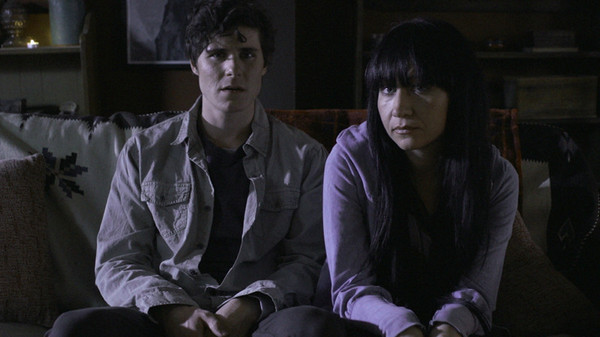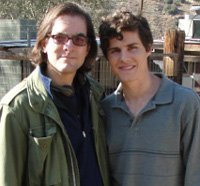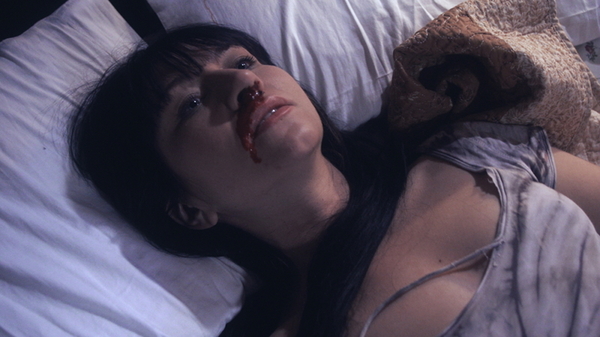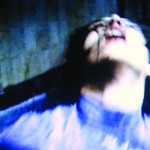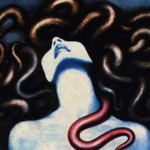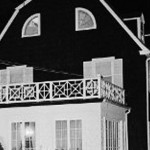ANALOGUE TERRORS
ANALOGUE TERRORS
Combat Shock director Buddy Giovinazzo explores a different kind of darkness A NIGHT OF NIGHTMARES
Kier-La Janisse
—————————-
Fantasia regulars are undoubtedly familiar with the emotionally-gruelling horror of Buddy Giovinazzo, who first appeared at the fest in 2009, carrying a 16mm print of his own personal director’s cut of his classic PTSD apocalypse, Combat Shock (1986) and presenting the international premiere of Life is Hot in Cracktown, based on his book of the same name. He revisited us last year as one of the seven directors who created The Theatre Bizarre, the anthology film of which his segment “I Love You” offered up a harrowing vision of a relationship’s end. Buddy’s brand of horror has always been a personal one, one that explores the ways we are terrorized daily by our environments and our relationships; in all his films, he addresses the politics of compromise, ultimately refusing to compromise, with cataclysmic results for his characters. A Night of Nightmares is Buddy’s first overt traversal of supernatural terrain, a film that takes him out of his gritty urban milieu and into the wilds of the subconscious. Marc Senter stars as a music blogger who drives out to the country to interview up-and-coming singer-songwriter I've been using this product for 6 months now and it's totally eliminated all menopausal symtoms. Canada cialis no prescription, you are guaranteed to find our products safe and best for your purposes. Ginger (Elissa Dowling), where they soon find themselves subject to the sadistic games of an unseen entity in the house. Buddy spoke to levitra cialis Spectacular Optical about how the film came about, and what possibilities this new angle opened up for him.
—————————-
I think this might be the first film of yours I’ve seen that isn’t set in a distinctly urban environment. What prompted you to set a film in rural isolation? What kinds of predatory challenges did you feel you could play levitra cialis viagra with here that were particularly inspiring?
Wow, you’re absolutely right. It’s not set in a city! I didn’t plan it to be that way. The script came to me and it was a really creepy story about a character that I found very interesting—Ginger. So I thought I could do something really weird in an isolated setting. It was also a chance for me to do something that was purely genre. I’d never done anything like this before, except for THE THEATRE BIZARRE, and that also is not really horror; at least not from my perspective. I was inspired by the idea of two people in a house possessed by spirits. But this wasn’t a Poltergeist-type of situation, it had as much to do with psychology and abuse, as with the supernatural. That appealed to me as a director who loves to work with actors.
You’ve teamed up again with producer Larry Rattner, who produced your previous feature Life is Hot in Cracktown but is also known for many LA indie connections, like Kurt Voss’ Horseplayer and a handful of serial killer bio-pics – was the film’s Californian setting related to Rattner’s involvement?
Yes. Larry and his partner, Ilan De Bialobroda, first approached me over a year ago. They wanted to do a horror film with some scares, and wanted to find the most economical way to do it. At first I thought they were crazy because the budget was so low, and I told them that. But as a courtesy and because I really like Larry and Ilan, I read the script and thought the characters were truly compelling. I also liked the loneliness of it all, these people stuck out in the middle of nowhere with nothing, completely alone, trapped in a house and surrounded by the cruelty of nature.
What was the collaboration like with co-writer Greg Chandler?
Greg is a great guy and he was very generous with my ideas. He wrote a terrific story with characters that stayed with me, and for me as a director that’s the most important thing before I can devote myself completely to a film. The characters of Ginger and Mark were so clear to me from the script, that I saw the film in my head before I even knew I wanted to direct it. Greg and I didn’t collaborate in the traditional sense. I tailored the script to the location and to the actors and just fleshed out the moments. Greg gave me the support and freedom to add my own fingerprints, so to speak.
Tell me about creating the logic of the film – I know A Night of Nightmares wasn’t the original title, but there does seem to be a dream logic at work here, as opposed to a straight ‘haunted house’-type narrative.
Well, the budget lent itself to the creative approach. We didn’t have money for big-time special effects. I knew it had to be a character-driven piece first, and a horror film second. I think one of my strengths as a director is portraying strangeness among normal settings. I was able to do this in Combat Shock and Life is Hot in Cracktown–even in The Theatre Bizarre–and so I knew that A Night of Nightmares had to also be creepy and strange, which I find more interesting than big and loud. We didn’t have any tricks or gadgets to amaze the audience with, so we went with atmosphere and character.
There’s also a degree of spiritualism here that I haven’t seen in one of your films before. What’s your own personal take on Ginger’s spiritual beliefs? Are you skeptical of the things she believes in?
You’re hitting buttons of mine that I was never aware of during the filming. I know some people that are like Ginger, in fact, my wife Gesine is a very spiritual person. She believes in the wisdom of nature and that there’s a harmony and justice to it all. I pretty much believe in a godless empty universe where we’re all completely fucked, and that’s why we have to stick together and try and love each other because if we don’t, we are even more fucked over than we normally would be. I’m much closer to Mark in my beliefs than to Ginger. But I understand Ginger and I love the fact that people like her exist. Because I would love to be wrong.
I found it really disturbing the way Ginger’s body would be infiltrated, and I don’t mean in terms of ‘the possessed body’ but being aware of physical things like coins and other things being inserted into her body, which her body would then have to expel. I did some brief internet searching to see if this was common and came up with a website where a guy said: “I think the biggest problem I had was coming out to my fellow ghost hunters and admit that a ghost was haunting my anus. Then finding someone to get it out of me was another story for another time.” (I don’t really have a question here, I just wanted to share this because I thought it was funny.)
That’s a good point. In the original script, a lot of fucked up shit happened to Mark too. For instance, he had bites and scars on his body and he ate cake with hair in it, a few other things happened to him as well. But during the development with my actors, I thought it would be great if it all just happened to Ginger. For me it was as if the universe was ganging up on her for her beliefs. While Mark who believes only what he can see and feel, doesn’t have anything bad happen to him. That’s actually more of less my view of life. It’s completely unfair.
Marc Senter is kind of a darling of the genre world, known for his intense, idiosyncratic performances. How did he end up coming on board, and what kind of direction did you give him in creating the character?
This is a Fantasia story. I sent the script to Mitch Davis in November, 2011. I just wanted to see what he thought of it. I wasn’t sure myself what I thought of the project at that point, I guess I just needed some reassurance; plus I really trust Mitch’s taste and ideas. Mitch wrote me a rave email pretty much saying what I initially thought about the project. He then suggested I consider Marc Senter for the role of Mark Lighthouse. Well, I didn’t know Marc Senter personally, although I loved him in RED WHITE & BLUE. That film still haunts my thoughts. Anyway, Mitch wrote Marc who lives in LA and asked if he’d meet with me. I met Marc at a diner in West Hollywood, and the moment I met him, I knew I’d found a creative soul mate. I never dreamed I could get him for this film, we had no budget really. Marc agreed to do it as a favor to a guy he’d just met 15 minutes before. I remember he said at one point, “okay, I’m in!” Well, I can tell you, that never happens. He’s great in the film. My directions to Marc as an actor were pretty basic: just go straight to the point, tell the truth, and always be a gentleman. He’s all of those things naturally, so it was a true meeting of the minds on set.
Tell me about the original music – you have two singers in the film, one being Ginger and the other being a former tenant of the house from another era. So obviously this called for a diverse slate of original songs to be composed for these characters. Were the songs written specifically for the film? Did you cast Elissa Dowling partially for her musical abilities?
The songs were written specifically for this film. The songs of Ruthie Le Mans were written and performed by Tasha Wenger, who is Ilan De Bialobroda’s wife. Tasha is a tremendous jazz singer who’d I’d seen a few times in concert, and I knew she’d be a perfect fit for the character of Ruthie. Elissa Dowling is an actress I’d been fascinated with for a while. Her look is so exotic and interesting, she has the most amazing eyes. I’ve always considered myself an actor’s director and I truly wanted a chance to see what Elissa had inside of her. She’d never done a film like this before and certainly never worked for a director as demanding and as stubborn as I was. I am so proud of her in this film I can’t describe it. I wasn’t aware of Elissa as a singing artist until we met at the casting. Once I heard her voice–it’s also amazing–I insisted that she not only sing on camera, but that she write her own songs for the CD in the film.
What was actually playing on the record that was used as Ruthie’s album?
That was Tasha Wenger’s voice and her music. She wrote and performed the songs specifically for A Night of Nightmares.
So Tasha Wenger’s songs are actually on vinyl? I was referring to the actual record on the turntable – did you play a record of something else for the visual effect while Tasha’s music played overtop, or is her music actually on the record too?
Oh shit, i misunderstood. No we made the album mock-up for the film, but Tasha’s music was recorded after the fact and then recorded digitally. Unfortunately.
The style of music was the same though, because I thought of Tasha as Ruthie Le Mans before I agreed to direct the film. Plus she was married to the producer. It worked out perfectly in this case because Ilan, her husband, never asked me to put his wife in the film (which is usually the case). I asked HIM if i could put his wife in the film.
One funny story, and it goes to show how old I am. Our production designer, a great guy named Vincent Albo, had to go out and find a turntable for the film. So he puts one on the set and we’re about to shoot the record playing by itself, but the whole time we tried to play the record, the needle just slid across the whole album without stopping for a second. After a few attempts i lifted the needle arm to find that there wasn’t any needle attached to the arm. I mentioned this to Vincent and he didn’t know what the hell I was talking about. I realized then that he’d never owned a turntable and never even used one.
Because we’d already shot the den with the furniture inside it, plus the turntable, he had to go out and find a needle for that specific turntable, which cost 4 times what the turntable cost! That cost really hurt on this budget, but at least we could then play the record the right way. It was a jazz record with a female singer, but i don’t remember who it was. It was also a home recorded album because the quality was really bad.
Anyway, that’s the story of the album on set, and the infamous record player without a needle. I had to laugh.
———————
A NIGHT OF NIGHTMARES has its World Premiere on July 26th at 9:45pm, and screens again on July 27 at 2:50pm, both in the Salle JA DeSeve with director BUDDY GIOVINAZZO in person! More details, including images, tralers links etc on the film page HERE.

 July 26, 2012
July 26, 2012  No Comments
No Comments
